RAM mounting solutions for media tablets
For when you want to take your tablet on the road, or just about anywhere else
by Contad H. Blickenstorfer
The folks at RAM-Mounts of Seattle, Washington hardly need an introduction. They are the undisputed leader in providing innovative rugged, durable mounting systems and docking stations for mobile electronics with their patented ball and socket mounting system that allows you to mount practically anything anywhere. The concept seems so simple—a comprehensive system of standardized and compatible mounting hardware all based on one central idea, that of using a clamp and rubber balls to hold things reliably in place. And easily adjust things any which way. Yet, there's nothing else that works as well, and at RuggedPCReview.com we've seen it all.
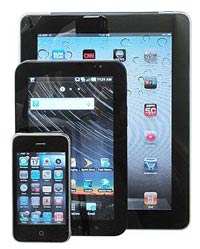 Anyway, there is now a new challenge and opportunity for RAM Mounts, and that is providing flexible, inexpensive mounting solutions for media tablets. Media tablets, of course, is a category of products that didn't even exist until Apple introduced the iPad in 2010. Tablet computers have been around for as long as two decades, but for the most part they were tablet versions of notebook computers, using notebook technology. Most were also thicker and heavier than iPad-style media tablets that are very slim and weigh very little. So mounting solutions for the new media tablets are different. Anyway, there is now a new challenge and opportunity for RAM Mounts, and that is providing flexible, inexpensive mounting solutions for media tablets. Media tablets, of course, is a category of products that didn't even exist until Apple introduced the iPad in 2010. Tablet computers have been around for as long as two decades, but for the most part they were tablet versions of notebook computers, using notebook technology. Most were also thicker and heavier than iPad-style media tablets that are very slim and weigh very little. So mounting solutions for the new media tablets are different.
Unlike older industrial and vertical market tablet computers that were for the most part low-colume solutions for specific problems, media tablets are selling by the millions. Apple alone sold 15 million iPads in 2010, and analyst firms predict very steep growth in the years ahead. Gartner, for example, predicts media tablet sales will reach 140 million in 2015, with Apple still selling almost half, and Android-based tablets a strong second, and also a good number of WebOS and QNX tablets. The majority of these tablets will be of the 7 and 10-inch variety, and millions of them will be used in business, in vehicles, in field offices, on shop floors and on numerous other jobs. Already we're seeing media tablets being used in new and innovative ways, such as in airplanes or as dashboard displays in cars. There's truly an app for almost anything, and that means tablets will be installed and mounted almost anywhere.
RAM mounting solutions for thin tablets
While Apple's iPad still dominates the market and will for a good while to come, there's now an increasing number of competitive media tablets, both in the 7-inch and the 10-inch class. RAM's universal Tab-Tite for tablets with thin cases, sleeves or skins is compatible with 7-inch class tablets such as the Samsung Galaxy Tab, the Dell Streak 7, the BlackBerry PlayBook, the Barnes & Noble NOOK color, and other slender tablets with a wide-format 7-inch display as long as they are between 6.75 and 9 inches long, no wider than 5.3 inches, and between 1/8 and 5/8 inches thick. The Tab-Tite holder is spring-loaded for quick release, the brackets are designed to provide access to just about any port, and the systems come with support cups for a perfect fit. The Tab-Tite is made of a high-strength composite material and is virtually indestructible. Here's what it looks like:
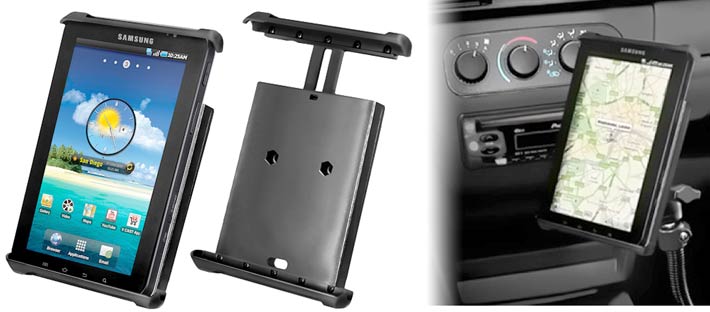
Below you can see the many ways a tablet can be mounted. From left to right:
- RAM twist lock suction cup mount for windshields
- RAM-A-CAN II cup holder mount
- RAM flat surface mount with universal AMPS hole pattern
- Yoke clamp mount for mounting on rails
- Rail mount for rails 0.5 to 1.25 inches

Note that RAM offers the same basic Tab-Tite concept also for tablets with thicker sleeves or cases. This increases maximum tablet + case dimensions to 9.75 x 5.75 x 1.06 inches (see Tab-Tite for thick tablets).
Tablets with different screen sizes and aspect ratios
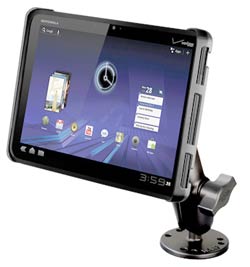 For now, it looks like the majority of media tablets will either have a 7-inch or a 10-inch display. While the difference between those display sizes doesn't sound like much, it is (as the picture on top of this page shows). And that's why even within RAM's flexible systems, one size does not fit all. Within a size class there can be significant differences. For now, it looks like the majority of media tablets will either have a 7-inch or a 10-inch display. While the difference between those display sizes doesn't sound like much, it is (as the picture on top of this page shows). And that's why even within RAM's flexible systems, one size does not fit all. Within a size class there can be significant differences.
For example, despite having the same nominal screen size, a device that uses the 4:3 aspect ratio like the iPad is wider and has a larger footprint than one that uses the 16:10 aspect ratio like, for example, the Motorola Xoom. The Xoom tablet is almost an inch narrower than the iPad, and so RAM designed a special version of the Tab-Tite mount for the Xoom.
Note that while RAM offers several versions of its spring-loaded quick-release Tab-Tite media tablet cradle to accommodate virtually all media tablets on the market (or coming to market), they all work with the same large variety of mounting arms. components and systems.
See RAM's page on mounting solutions for the Motorola Xoom.
RAM mounting solutions for iPad, iPad 2 and similar
Apple sold about 15 million first generation iPads in 2010 alone, then followed up with the introduction of the iPad 2 which has virtually identical proportions, but is a bit thinner yet. RAM's special Tab-Tite cradle for the Apple iPad fits both the original and the iPad 2, and also iPads with bumpers or cases (including the Otterbox case). It also fits other tablets with similar dimensions, making it a natural for the HP TouchPad. Some of the more compact 10-inch will fit as well (see RuggedPCReview's media tablet table).
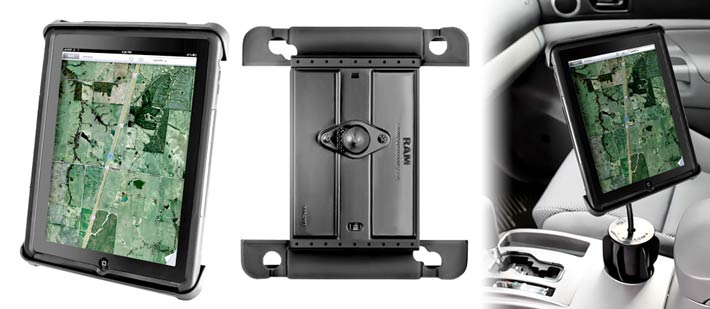
The most popular mounting solutions here are:
- RAM POD I, universal No-Drill vehicle mount
- RAM twist lock suction cup mount for windshields
- RAM-A-CAN II cup holder mount
- RAM flat surface mount with universal AMPS hole pattern
- Yoke clamp mount for mounting on rails
- Rail mount for rails 0.5 to 1.25 inches
Check RAM Tablet Mounts for iPad and iPad 2.
RAM rugged Handi-Case for iPad and iPad 2
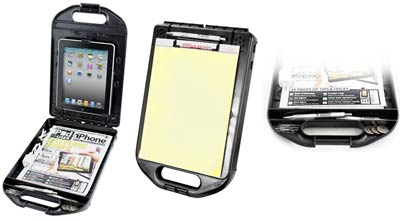 If a regular case won't do, there's always the Rugged Handi-Case for the Apple iPad and iPad 2. It's a big, tough case that has a cradle for the iPad, multiple punch-outs on the sides and back for running power into or out of the case, and even storage spaces inside the case for documents, coins, or whatever. Outside, you can attach an old-fashioned pad of paper and a pen, for those rare occasions where the iPad needs some hard copy help. If a regular case won't do, there's always the Rugged Handi-Case for the Apple iPad and iPad 2. It's a big, tough case that has a cradle for the iPad, multiple punch-outs on the sides and back for running power into or out of the case, and even storage spaces inside the case for documents, coins, or whatever. Outside, you can attach an old-fashioned pad of paper and a pen, for those rare occasions where the iPad needs some hard copy help.
Here a couple of words on cases in general. Over the years since we started Pen Computing Magazine in 1993, we've tried hundreds of them for PDAs, Pocket PCs, tablets, and notebooks. What we found is that people either love or hate a case. There doesn't seem to be anything inbetween. For example, we all use iPads here at RuggedPCReview.com, and all of those iPads are in Apple's portfolio sleeve/case. It's not very attractive but it simply works and I never use my own iPad without it. RAM's Handi-Case is another one of these products that many users simply won't ever want to be without.
When security matters: RAM Locking Cradles for iPad and iPad 2
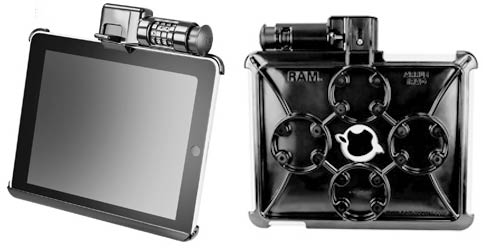 While media tablets are quite affordable compared to some high end ruggedized hardware, they are also small and light and thus an easy target for thieves. The thought behind the upcoming RAM Locking Cradle was to provide enough of a deterrent to make would-be thieves think twice and move on to easier targets. While media tablets are quite affordable compared to some high end ruggedized hardware, they are also small and light and thus an easy target for thieves. The thought behind the upcoming RAM Locking Cradle was to provide enough of a deterrent to make would-be thieves think twice and move on to easier targets.
The concept of the cradle is simple: use a dial combination lock that secures the iPad tablet to the high strength composite cradle that provides easy access to ports and has four mounting points with pre-drilled holes, including the universal AMPS hole pattern.
Bottom line:
With media tablets being such a large market, there are any number of very good cases, including rugged ones. We like RAM not only because of their peerless ball-and-joint system, but also because they've been in this market for a long time, because everything within their system works with everything else, and because they simply know what works and does not work on the job.
|




